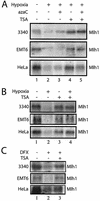Decreased expression of the DNA mismatch repair gene Mlh1 under hypoxic stress in mammalian cells
- PMID: 12697826
- PMCID: PMC153206
- DOI: 10.1128/MCB.23.9.3265-3273.2003
Decreased expression of the DNA mismatch repair gene Mlh1 under hypoxic stress in mammalian cells
Abstract
The hypoxic tumor microenvironment has been shown to contribute to genetic instability. As one possible mechanism for this effect, we report that expression of the DNA mismatch repair (MMR) gene Mlh1 is specifically reduced in mammalian cells under hypoxia, whereas expression of other MMR genes, including Msh2, Msh6, and Pms2, is not altered at the mRNA level. However, levels of the PMS2 protein are reduced, consistent with destabilization of PMS2 in the absence of its heterodimer partner, MLH1. The hypoxia-induced reduction in Mlh1 mRNA was prevented by the histone deacetylase inhibitor trichostatin A, suggesting that hypoxia causes decreased Mlh1 transcription via histone deacetylation. In addition, treatment of cells with the iron chelator desferrioxamine also reduced MLH1 and PMS2 levels, in keeping with low oxygen tension being the stress signal that provokes the altered MMR gene expression. Functional MMR deficiency under hypoxia was detected as induced instability of a (CA)(29) dinucleotide repeat and by increased mutagenesis in a chromosomal reporter gene. These results identify a potential new pathway of genetic instability in cancer: hypoxia-induced reduction in the expression of key MMR proteins. In addition, this stress-induced genetic instability may represent a conceptual parallel to the pathway of stationary-phase mutagenesis seen in bacteria.
Figures







Similar articles
-
Alterations in PMS2, MSH2 and MLH1 expression in human prostate cancer.Int J Oncol. 2003 May;22(5):1033-43. Int J Oncol. 2003. PMID: 12684669
-
Molecular characterization of the spectrum of genomic deletions in the mismatch repair genes MSH2, MLH1, MSH6, and PMS2 responsible for hereditary nonpolyposis colorectal cancer (HNPCC).Genes Chromosomes Cancer. 2005 Oct;44(2):123-38. doi: 10.1002/gcc.20219. Genes Chromosomes Cancer. 2005. PMID: 15942939
-
Immunohistochemical analysis reveals high frequency of PMS2 defects in colorectal cancer.Gastroenterology. 2005 May;128(5):1160-71. doi: 10.1053/j.gastro.2005.01.056. Gastroenterology. 2005. PMID: 15887099
-
[Gastric cancer and microsatellite instability].Nihon Shokakibyo Gakkai Zasshi. 2002 Sep;99(9):1043-9. Nihon Shokakibyo Gakkai Zasshi. 2002. PMID: 12355890 Review. Japanese. No abstract available.
-
A review of mismatch repair gene transcripts: issues for interpretation of mRNA splicing assays.Clin Genet. 2015 Feb;87(2):100-8. doi: 10.1111/cge.12450. Epub 2014 Jul 26. Clin Genet. 2015. PMID: 24989436 Review.
Cited by
-
Differential expression of checkpoint markers in the normoxic and hypoxic microenvironment of glioblastomas.Brain Pathol. 2023 Jan;33(1):e13111. doi: 10.1111/bpa.13111. Epub 2022 Sep 12. Brain Pathol. 2023. PMID: 36093941 Free PMC article.
-
Secondary mutation in a coding mononucleotide tract in MSH6 causes loss of immunoexpression of MSH6 in colorectal carcinomas with MLH1/PMS2 deficiency.Mod Pathol. 2013 Jan;26(1):131-8. doi: 10.1038/modpathol.2012.138. Epub 2012 Aug 24. Mod Pathol. 2013. PMID: 22918162 Free PMC article.
-
The yeast environmental stress response regulates mutagenesis induced by proteotoxic stress.PLoS Genet. 2013;9(8):e1003680. doi: 10.1371/journal.pgen.1003680. Epub 2013 Aug 1. PLoS Genet. 2013. PMID: 23935537 Free PMC article.
-
Comprehensive analysis of common mitochondrial DNA variants and colorectal cancer risk.Br J Cancer. 2008 Dec 16;99(12):2088-93. doi: 10.1038/sj.bjc.6604805. Epub 2008 Dec 2. Br J Cancer. 2008. PMID: 19050702 Free PMC article.
-
Current Understanding and Management of Intraductal Carcinoma of the Prostate.Curr Oncol Rep. 2021 Jul 16;23(9):110. doi: 10.1007/s11912-021-01090-2. Curr Oncol Rep. 2021. PMID: 34272624 Review.
References
-
- Avila, M. A., M. V. Carretero, E. N. Rodriguez, and J. M. Mato. 1998. Regulation by hypoxia of methionine adenosyltransferase activity and gene expression in rat hepatocytes. Gastroenterology 114:364-371. - PubMed
-
- Baker, S. M., A. W. Plug, T. A. Prolla, C. E. Bronner, A. C. Harris, X. Yao, D. M. Christie, C. Monell, N. Arnheim, A. Bradley, T. Ashley, and R. M. Liskay. 1996. Involvement of mouse Mlh1 in DNA mismatch repair and meiotic crossing over. Nat. Genet. 13:336-342. - PubMed
-
- Baylin, S. B., M. Esteller, M. R. Rountree, K. E. Bachman, K. Schuebel, and J. G. Herman. 2001. Aberrant patterns of DNA methylation, chromatin formation and gene expression in cancer. Hum. Mol. Genet. 10:687-692. - PubMed
-
- Berk, J. L., N. Massoomi, C. Hatch, and R. H. Goldstein. 1999. Hypoxia downregulates tropoelastin gene expression in rat lung fibroblasts by pretranslational mechanisms. Am. J. Physiol. 277:L566-572. - PubMed
-
- Brizel, D. M., S. P. Scully, J. M. Harrelson, L. J. Layfield, J. M. Bean, L. R. Prosnitz, and M. W. Dewhirst. 1996. Tumor oxygenation predicts for the likelihood of distant metastases in human soft tissue sarcoma. Cancer Res. 56:941-943. - PubMed
Publication types
MeSH terms
Substances
Grants and funding
LinkOut - more resources
Full Text Sources
Other Literature Sources
Research Materials
Miscellaneous
